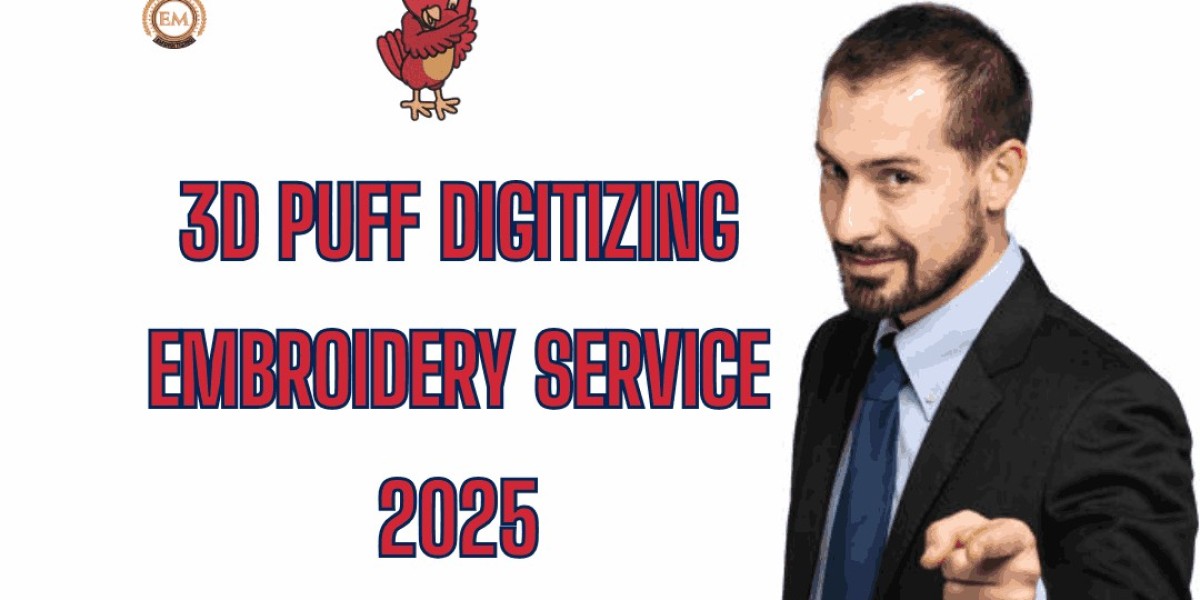A digitizing embroidery service creates digital stitch files that bring designs to life, and 3D puff embroidery stands out for its bold, raised effect, adding dimension to logos and patterns. In 2025, 3D puff designs are popular for caps, jackets, and sportswear, requiring specialized digitizing to achieve professional results. This blog explores how a digitizing embroidery service prepares 3D puff designs, highlighting techniques, challenges, and best practices for stunning outcomes.
By partnering with a skilled service, you can elevate your projects with eye-catching embroidery. The best embroidery digitizing practices ensure 3D puff designs are precise, durable, and visually impactful. Let’s dive into the world of 3D puff embroidery digitizing.
What Is 3D Puff Embroidery?
3D puff embroidery uses foam underlay beneath stitches to create a raised, three-dimensional effect, making designs pop on fabrics. Common in bold logos or text on caps and jackets, it adds tactile and visual appeal, distinguishing it from flat embroidery. A digitizing embroidery service crafts stitch files that secure the foam, ensuring a clean, professional finish.
The embroidery digitizing process for 3D puff requires expertise in stitch density, underlay, and foam placement to prevent issues like exposed foam or fabric distortion. This specialized technique enhances branding and fashion projects, making it a sought-after service in 2025.
Why Choose a Professional Digitizing Service for 3D Puff?
3D puff embroidery demands precision, as improper digitizing can lead to foam tears, uneven stitches, or fabric damage. A professional digitizing embroidery service ensures designs are optimized for foam coverage, fabric compatibility, and machine performance, delivering durable, high-quality results. Their expertise minimizes errors, saving time and resources.
By leveraging advanced tools and fabric knowledge, these services create stitch files that achieve the desired raised effect, enhancing your project’s aesthetic. Choosing a skilled service is essential for mastering 3D puff embroidery in 2025.
Key Elements of 3D Puff Digitizing
Digitizing for 3D puff involves unique considerations compared to flat embroidery:
Foam Underlay: Requires dense stitches to cover foam securely.
Stitch Density: Higher density ensures no foam exposure.
Underlay Stitches: Heavy underlay stabilizes foam and fabric.
Fabric Compatibility: Thicker fabrics like denim or caps work best.
These elements guide the embroidery digitizing process, ensuring 3D puff designs are bold and durable. A great service addresses each aspect meticulously, aligning with client goals in 2025.
Understanding 3D Puff Requirements
To digitize 3D puff, services consider these:
Foam Thickness: Match foam to design size for balance.
Stitch Coverage: Plan dense stitches for foam security.
Fabric Selection: Choose stable materials for support.
Design Simplicity: Simplify details for raised effects.
Proper planning enhances 3D puff quality.
Step 1: Analyze Artwork for 3D Puff
A digitizing service starts by analyzing the artwork, ensuring it’s suitable for 3D puff embroidery. They prefer vector files (.SVG, .AI) or high-resolution bitmaps (300 DPI) for clarity, identifying areas like text or logos for raised effects. Complex details are simplified to accommodate foam thickness and stitch coverage.
This analysis ensures the design translates into a raised, professional stitch file, maintaining clarity and impact. Thorough artwork preparation is a critical step in 3D puff embroidery digitizing, setting the stage for success in 2025.
Artwork Analysis Tips
To prepare artwork, services use these:
Use Vector Files: Ensure precision for raised areas.
Mark Puff Sections: Identify elements for foam placement.
Simplify Details: Adjust fine lines for 3D compatibility.
Preview Digitally: Visualize puff effects before digitizing.
Accurate analysis drives design success.
Step 2: Select Dense Satin Stitches
Dense satin stitches are ideal for 3D puff, as they cover foam smoothly, creating a polished raised effect. Digitizing services use satin stitches for text or logo outlines (up to 10mm wide), ensuring full foam coverage. Running stitches may outline designs to secure edges, enhancing definition.
Testing stitch types on sample fabrics confirms their performance, preventing gaps or foam exposure. Strategic stitch selection is essential for achieving the bold, three-dimensional look of 3D puff embroidery in 2025.
Stitch Selection Strategies
To choose stitches, services use these:
Dense Satin for Coverage: Ensure foam is fully concealed.
Running for Outlines: Add definition to puff edges.
Test Stitch Performance: Verify smoothness on samples.
Adjust for Foam: Match stitches to foam thickness.
Tailored stitches optimize puff effects.
Step 3: Optimize Stitch Density and Underlay
High stitch density (e.g., 0.3mm spacing) is crucial for 3D puff to prevent foam exposure, while heavy underlay (e.g., double zigzag) stabilizes the foam and fabric, especially on stretchy materials like knits. Digitizing services adjust these settings to ensure the raised design remains secure and durable.
Digital previews and fabric tests verify density and underlay performance, ensuring the design withstands wear. Optimized settings are a cornerstone of the best embroidery digitizing practices for 3D puff in 2025.
Density and Underlay Tips
To optimize settings, services use these:
High Density for Puff: Secure foam with tight stitches.
Heavy Underlay: Use double zigzag for stability.
Test on Fabrics: Confirm settings prevent foam tears.
Preview Adjustments: Check simulations for balance.
Custom settings enhance puff durability.
Step 4: Plan Stitch Paths for Stability
Stitch paths determine the order and direction of stitches, impacting foam stability and fabric tension. Digitizing services plan paths to secure foam first, stitching raised areas before outlines to prevent shifting. They minimize thread trims to maintain efficiency and reduce fabric stress.
Aligning paths with fabric grain or design curves ensures a smooth, stable puff effect, critical for thick fabrics like denim. Efficient path planning is vital for professional 3D puff embroidery digitizing in 2025.
Path Planning Strategies
To plan paths, services use these:
Secure Foam First: Stitch puff areas to stabilize foam.
Minimize Trims: Sequence for continuous stitching.
Align with Grain: Reduce tension on fabric curves.
Preview Paths: Ensure flow prevents distortion.
Optimized paths improve puff stability.
Step 5: Test Designs on Target Fabrics
Testing is essential to ensure 3D puff stitch files perform well. Digitizing services stitch samples on the target fabric, using the same thread, foam, and stabilizer as the final product. They inspect for foam coverage, stitch alignment, and durability, adjusting density or paths if issues like foam tears or puckering arise.
Rigorous testing guarantees the raised design meets professional standards, ensuring client satisfaction. This iterative process is a key part of quality 3D puff digitizing services in 2025.
Testing Best Practices
To test 3D puff designs, services use these:
Match Materials: Use identical fabric, foam, and thread.
Inspect Foam Coverage: Ensure no exposure or tears.
Check Stability: Verify puff withstands wear.
Refine Settings: Adjust based on sample results.
Testing ensures flawless puff embroidery.
Fabric Considerations for 3D Puff
Thicker, stable fabrics like denim, twill, or canvas are ideal for 3D puff, as they support foam’s bulk without distortion. Stretchy fabrics like knits require cut-away stabilizers and heavy underlay to maintain stability. Digitizing services test fabrics to confirm compatibility, ensuring the puff effect enhances the material.
Choosing the right fabric and stabilizer combination prevents issues like sinking stitches or foam shifting, critical for professional results. Fabric expertise is a defining trait of top 3D puff digitizing services in 2025.
Fabric Selection Tips
To choose fabrics, services use these:
Prefer Stable Fabrics: Use denim or twill for puff support.
Stabilize Stretchy Fabrics: Apply cut-away for knits.
Test Fabric Samples: Confirm compatibility with foam.
Match Stabilizers: Use tear-away for stable materials.
Fabric compatibility boosts puff quality.
Challenges in 3D Puff Digitizing
Digitizing for 3D puff presents unique challenges, but solutions exist:
Challenge: Foam Exposure
Solution: Use dense satin stitches and high density.Challenge: Fabric Distortion
Solution: Apply heavy underlay and stable fabrics.Challenge: Foam Shifting
Solution: Secure foam with initial stitches and proper paths.Challenge: Complex Designs
Solution: Simplify details for puff compatibility.
Addressing these ensures high-quality 3D puff embroidery.
How Technology Enhances 3D Puff Digitizing
Modern technology streamlines 3D puff embroidery digitizing:
3D Previews: Visualize raised effects for accuracy.
Auto-Density Tools: Optimize stitches for foam coverage.
Specialty Stitch Modules: Support puff-specific settings.
Cloud Collaboration: Share previews and files with clients.
These tools enhance precision and efficiency, ensuring professional 3D puff designs. Technology is a key enabler of the best embroidery digitizing practices for puff embroidery in 2025.
Technology Utilization Tips
To leverage technology, services use these:
Use 3D Previews: Verify puff height and coverage.
Apply Auto-Density: Optimize for foam security.
Access Puff Modules: Use settings for raised effects.
Test Tool Outputs: Confirm machine compatibility.
Technology boosts puff digitizing precision.
Collaborating with a Digitizing Service
Clients play a vital role in 3D puff digitizing by providing clear artwork, fabric details, and design preferences. Digitizing services request vector files and specs like foam thickness or placement, offering digital previews for feedback. Clear communication aligns the stitch file with the client’s vision, reducing revisions.
Feedback on test samples refines the design, ensuring the raised effect meets expectations. Effective collaboration is critical for delivering successful 3D puff embroidery in 2025.
Collaboration Best Practices
To collaborate effectively, services use these:
Request Vector Artwork: Use .SVG or .AI for clarity.
Clarify Puff Goals: Discuss raised areas and aesthetics.
Share Digital Previews: Provide simulations for review.
Involve Clients in Testing: Seek feedback on samples.
Client collaboration ensures puff success.
Applications of 3D Puff Embroidery
3D puff embroidery enhances various projects:
Branded Caps: Create bold logos for promotional wear.
Sportswear: Add raised team names to jerseys or jackets.
Fashion Accessories: Digitize textured designs for bags or belts.
Event Merchandise: Craft eye-catching logos for event gear.
These applications showcase the versatility of 3D puff digitizing services.
Tips for Clients Using 3D Puff Digitizing Services
Clients can optimize their experience with these tips:
Provide High-Quality Artwork: Submit vector files for precision.
Specify Fabric and Foam: Share material details upfront.
Clarify Design Goals: Define puff areas and aesthetic preferences.
Review Previews Promptly: Offer feedback to avoid delays.
Test Samples Early: Confirm results before production.
These strategies ensure successful 3D puff outcomes.
Conclusion
A digitizing embroidery service for 3D puff designs delivers bold, raised embroidery by analyzing artwork, selecting dense satin stitches, optimizing density and underlay, planning stable paths, and testing rigorously. By addressing challenges like foam exposure and leveraging technology for precision, these services create professional stitch files that enhance caps, jackets, and more in 2025. The best embroidery digitizing practices ensure 3D puff designs are durable, visually striking, and aligned with client visions. Partner with a skilled digitizing service today to elevate your projects with stunning 3D puff embroidery.
FAQs
Q: What makes a digitizing embroidery service ideal for 3D puff?
Expertise in dense satin stitches, foam placement, and fabric compatibility ensures professional, durable 3D puff designs.
Q: Why is testing important for 3D puff digitizing?
Testing verifies foam coverage, stitch stability, and fabric compatibility, preventing issues like exposure or distortion.
Q: What fabrics are best for 3D puff embroidery?
Stable fabrics like denim or twill support foam’s bulk, while stretchy knits need cut-away stabilizers for stability.
Q: How does technology aid 3D puff digitizing?
3D previews, auto-density tools, and puff modules enhance precision and efficiency for professional raised designs.
Q: How can clients support 3D puff digitizing services?
Provide vector artwork, specify fabric and foam details, review previews, and offer feedback on samples for success.






